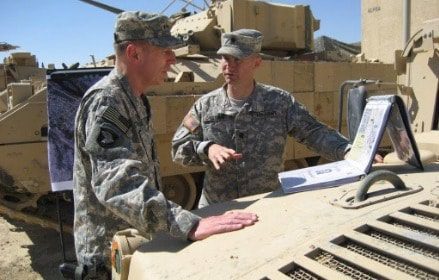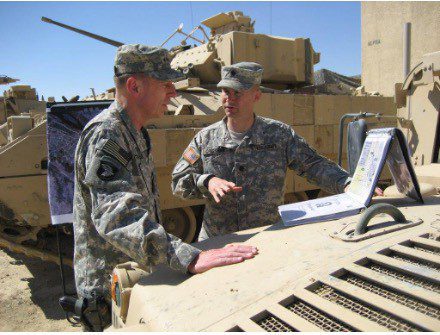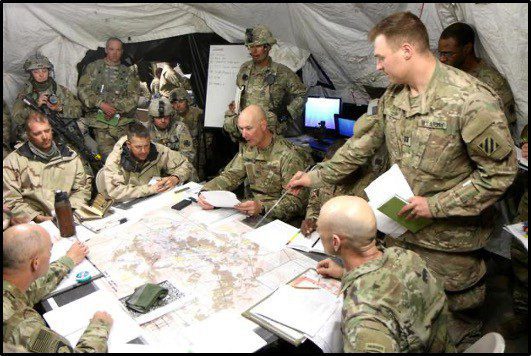I Don’t Know What I’ve Said Until You Tell Me What You’ve Heard


The military characteristically operates in volatile, uncertain, complex and ambiguous (VUCA) environments where detailed planning and flexible execution are critical to mission success. Time is typically short, details often sketchy, and opportunities very often fleeting. Sound familiar? Communication—up, down, and laterally across the team—is vital to any organization’s ability to seize and maintain the initiative. A leader’s ability to clearly communicate his/her vision of success helps guide subordinates’ actions when things don’t go as planned and can represent the difference between success and failure. To address this communication challenge, the military uses three linked techniques—Commander’s Intent, Confirmation Brief and Backbrief—to deliver the mission, validate the recipients’ understanding, and clarify each teammate’s role in contributing to the mission’s successful completion.
In early 2007, as a Battalion Commander in the U.S. Army responsible for an 850-Soldier task force deployed to Iraq, I assumed responsibility for a particularly challenging area of operations. Just a few weeks before my military unit arrived, the CIA had declared Anbar Province the most dangerous province in Iraq and among the most volatile places in the world. The previous unit had done tremendous work but had made little progress toward improving the security environment. We knew we had to try something different, and I knew I had a communication challenge before me.

Within 10 days of arrival, we gathered input from local tribal leaders and partnered with local security forces to develop a plan to clear the primary urban area in our sector, maintain its security through joint (U.S. and Iraqi Police) presence in the roughest parts of town, and aggressively patrol and police the streets to gradually allow basic services, and ultimately, commerce to return to the city. Dubbed Operation Shurta Nasir (Police Victory), it was a bold move and no small undertaking. There was a fair amount of understandable apprehension amongst my Soldiers and our Iraqi partners. Communicating the plan clearly and effectively was crucial to build confidence, encourage grassroots thinking, spur initiative, and instill a bias for action. As important, I needed multiple means to confirm shared understanding across my team, verify their preparedness, and identify areas of greatest risk as I refined our plan.
Prior to any military operation, and as a key part of mission planning and preparation, the leader develops his/her “Commander’s Intent”—a concise statement laying out the purpose of the operation, the key tasks associated with success, and the conditions that define the desired end state. As leaders visualize an operation, they use their Intent Statement to describe, in simple terms, WHY the operation must succeed, the key actions the team must take to achieve the desired end state, and the future conditions the leader wants to exist when the operation is complete.
This intent is shared two echelons down from the leader’s position to ensure everyone understands what their boss—and their boss’ boss—is seeking to accomplish…and why. It provides important context and perspective for subordinates to better understand what the leader is thinking, the key actions the team must complete along the way, and what is gained if all goes well. This view inside the leader’s head helps subordinates seize opportunities, make snap decisions, understand the complementary activities they and their teammates are responsible for, and above all, exercise initiative if conditions don’t allow them to seek guidance during execution.
Ideally, they can answer their own questions and take action because they understand what the boss is thinking and, therefore, what he/she would want them to do when faced with a particular situation. While only a small part of any complete military operations order, the Commander’s Intent statement is generally regarded as the most important. Leaders typically prepare and deliver their Intent Statements themselves for added emphasis. While all parts of a detailed order have value, the Commander’s Intent is generally regarded as the portion all players must truly understand and internalize.
The purpose of this operation is to establish a permanent, joint (U.S. and Iraqi) security presence at multiple locations throughout the city in order to protect and reassure the population, deter insurgent activity, bolster confidence in the Iraqi Security Forces, and set conditions for the return of basic services.
– Establish three jointly manned police stations in the most dangerous parts of the city
– Control access to the city’s main road networks
– Secure the hospital
When complete, our city’s population will see their own Iraqi Police and Army securing their city’s perimeter and streets visibly supported by U.S. soldiers and equipment. Medical care will be accessible to all who need it. Our 24/7 joint presence will deter insurgent activity and restore the population’s confidence in our ability to keep them safe. We will secure the 99% of the population who are good and enlist their support to ultimately defeat the 1% who wish to do us harm.
If my soldiers remembered nothing else from the detailed operations order, this information would give them enough to understand what I was thinking, WHY it was important we succeed, what we were seeking to accomplish, and the key components of that success.

With the new order issued, subordinate leaders and teams immediately begin shifting gears and developing their supporting plans. At this stage, it’s useful to verify what everyone heard before they go too far down the road planning their parts. The Confirmation Brief is intended to occur very shortly after receiving the operations order and requires subordinate leaders to confirm what they heard with their higher commander. These briefs should take only a few minutes per subordinate and are typically delivered in front of a terrain model, map, or sketch that provides helpful clarity to the conversation. Units often have prescribed formats for Confirmation Briefs, but subordinate leaders typically present:
• “This is WHY we are doing what we’re doing.”
• “This is my unit’s specific TASK and PURPOSE.”
• “This is what my teammates will be doing in relation to, or in support, of my efforts.”
• “This is what success looks like from my unit’s perspective.”
Once my staff and I had finished delivering the operations order for Operation Shurta Nasir, I huddled my six subordinate commanders around our large map of the city and asked them each to confirm their understanding of what I had asked them to do. I started with the leader who was the battalion’s main effort and followed with each of the supporting efforts in sequence. They referred to their notes where words or details were important, but otherwise talked from memory while pointing at the map. The process helped me visualize how they saw their unit contributing to the success of the larger operation and the dialogue helped me advance my thinking and refine my guidance as much as it helped my leaders confirm their understanding of my instructions.
The discussion also highlighted multiple areas where they would rely on each other for support and assistance and allowed that coordination to begin. Because it was possible for all my subordinate leaders to listen to their peers’ Confirmation Briefs, it expanded their appreciation for the larger picture and helped them recognize potential disconnects, challenges, or coordination requirements. With practice, the Confirmation Brief process consumes only a few minutes, but often saves hours or days of frustration or wasted effort due to a misinterpretation of what the boss wants.
Armed with clear guidance and direction from the Confirmation Brief, the subordinate leaders return to their teams and now have some time to develop their plans. Based on time available, the leader then finds a time to receive a Backbrief from each subordinate leader. The Backbrief is an opportunity for each subordinate leader to explain to the boss HOW they intend to accomplish the mission they’ve been given. Like the Confirmation Brief, units typically have their own formats for the Backbrief, but all provide a framework that allows the subordinate to talk the boss through their contribution to the larger plan from start to finish.
• Their Mission (Task and Purpose)
• Their Commander’s Intent
• General concept of the operation
• Key Timings
• Key Points of coordination with adjacent units/teams
• Any Perceived Risks to the Force
• Any Perceived Risks to the Mission
In the days and hours prior to commencing Operation Shurta Nasir, I made time to visit each of my subordinate leaders at their locations to receive a Backbrief. In most cases, the leaders had created large terrain models of the portions of the city they’d be operating in. They walked me through each step of their operation in time and space. They highlighted where they were counting on support from other elements and where they had concerns. Receiving the Backbriefs further matured my understanding of the intricacies of our operation and where the most significant risks might lie. The process also resulted in additional guidance to my staff to ensure we were best postured to enable the success of each of our subordinate units.
Operation Shurta Nasir was an overwhelming success. Many of the specific actions and activities didn’t occur as planned, but leaders on the ground understood my intent and made decisions on the fly that ultimately contributed to our desired end state. When the sun came up after a long night of operations with our Iraqi partners, we owned the city and were able to spend the next several months improving our posture. With each passing day, the population’s confidence in our ability to keep them safe grew allowing basic services to return and commerce to flourish. I’m certain that integrating a clear Commander’s Intent with structured Confirmation Briefs and Backbriefs helped us achieve shared understanding of a complex plan during a challenging time period.
How could these techniques help in your organization? The post-pandemic, hybrid work environment has made communication and gaining shared understanding across dispersed teams more challenging than ever before. While created for, and employed routinely by our military, these simple practices can enhance your organization’s effectiveness in today’s dynamic corporate world. Your Commander’s or Leader’s Intent may be delivered in the boardroom instead of on a battlefield and your Backbriefs may occur on a factory floor or data center rather than on a remote hilltop or critical piece of terrain, but the clarity and commitment they drive and the initiative they inspire will pay dividends for you and your teams.
Although recently retired from the military, I am fortunate to continue practicing and teaching these vital tools to senior executives and companies across all industries through leadership development programs at Thayer Leadership. Regardless of your business or current challenge, communicating clearly to clarify what you say and confirming what your teams have actually heard is always a worthwhile endeavor.

Chief Executive Group exists to improve the performance of U.S. CEOs, senior executives and public-company directors, helping you grow your companies, build your communities and strengthen society. Learn more at chiefexecutivegroup.com.
0

1:00 - 5:00 pm
Over 70% of Executives Surveyed Agree: Many Strategic Planning Efforts Lack Systematic Approach Tips for Enhancing Your Strategic Planning Process
Executives expressed frustration with their current strategic planning process. Issues include:
Steve Rutan and Denise Harrison have put together an afternoon workshop that will provide the tools you need to address these concerns. They have worked with hundreds of executives to develop a systematic approach that will enable your team to make better decisions during strategic planning. Steve and Denise will walk you through exercises for prioritizing your lists and steps that will reset and reinvigorate your process. This will be a hands-on workshop that will enable you to think about your business as you use the tools that are being presented. If you are ready for a Strategic Planning tune-up, select this workshop in your registration form. The additional fee of $695 will be added to your total.

2:00 - 5:00 pm
Female leaders face the same issues all leaders do, but they often face additional challenges too. In this peer session, we will facilitate a discussion of best practices and how to overcome common barriers to help women leaders be more effective within and outside their organizations.
Limited space available.

10:30 - 5:00 pm
General’s Retreat at Hermitage Golf Course
Sponsored by UBS
General’s Retreat, built in 1986 with architect Gary Roger Baird, has been voted the “Best Golf Course in Nashville” and is a “must play” when visiting the Nashville, Tennessee area. With the beautiful setting along the Cumberland River, golfers of all capabilities will thoroughly enjoy the golf, scenery and hospitality.
The golf outing fee includes transportation to and from the hotel, greens/cart fees, use of practice facilities, and boxed lunch. The bus will leave the hotel at 10:30 am for a noon shotgun start and return to the hotel after the cocktail reception following the completion of the round.